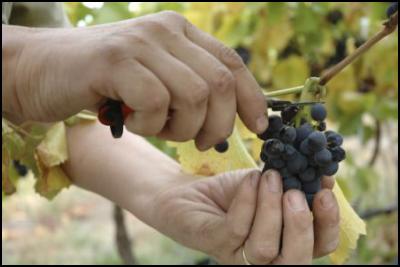Tobacco, vanilla, toast: how wine gets its flavour
Tobacco, vanilla and toast: How does wine get its flavour?


Tobacco, vanilla and toast: How does wine get its flavour?
Whether you’re a wine connoisseur or an enthusiastic amateur, you’re bound to be able to discern different flavours in the wines you drink. Berries, leather and even cigar notes can all be detected in different wines, but they are not used in the winemaking process. So how do wines get these flavours?
“Every stage of the winemaking process has a part to play in the finished result,” says Alpha Domus wine expert, Paul Ham. “One of the most important factors is where the grapes are grown.”
Winemakers use the term terroir to denote the special characteristics geography gives to a wine- including soil and microclimate. Each region has its own distinctive flavour traits.
“Alpha Domus’ Hawke’s Bay vineyard is sited on an old river bed covered with about a foot of topsoil. This gives our grapes their own unique qualities,” says Paul.
Once the perfect site has been chosen, the battle begins to ensure each vintage produces the perfect crop of quality grapes. Weather, insects and birds are all potential threats.
Paul says this year looks set to be an excellent vintage for New Zealand wines. Temperatures have been fairly high this summer and not a lot of rain is forecast for the next few months.
“We find that a bad year for farmers is often a good year for vineyards because we benefit from long, hot periods. However, there were frosts at the beginning of the season in many regions, which will mean some quite small yields.”
The size of those yields will be determined over the next month, with most vineyards starting their first picking in March. Paul says the winemaker works with the viticulturalist to decide the best time to pick.
“The winemaker’s palate really is the best tool in the winery.
“The most important parameter that dictates when to harvest is the taste. At this time of year, the winemaker is tasting and analysing our grapes every day to determine when the right balance of sugar, acid and other flavour components is achieved.”
Once the white grapes have been picked, they're pressed to extract the juice. At Alpha Domus, the red grapes are destemmed and crushed, then pumped into a tank with a large hose.
“The mixture is then chilled at 8 to 10 degrees, what we call a cold soak. This process brings out some lovely fruit flavours. This is how our award-winning Navigator wine gets its raspberry and boysenberry notes.”
Red wines get their colour from being fermented with their skins. The fermentation temperatures affect the wine’s flavour. Red wines ferment at between 25 and 32 degrees and the fermentation process is completed in about five days.
“The grape skins float to the top and form a hard cap, which is so dense you can almost walk on it. We plunge the skins, either by hand or by pump, to break up the cap and extract tannins, flavour and colour.”
Whites are fermented at cool temperatures, between 10 and 20 degrees, to preserve their varietal fruit flavours.
Toasted brioche flavours, like those found in Viognier, are produced by keeping the barrels full and stirring them with a stick (known as batonage) every few days to keep the yeast in suspension.
Once the fermentation process is complete, many wines are then stored in oak barrels – yet another source of flavour.
“French oak barrels give vanillin, clove and other spice flavours, which have a lot of finesse. American oak is sweeter, giving whiskey, bourbon and coconut qualities.”
Paul says a really robust wine can be a long time in the making.
“Our Aviator Cabernet blend spends two years in French oak barrels. This contributes to its sweet red berry flavours and hints of chocolate, spices and tannins. The total time between the vines budding and this wine being bottled is about three years.”
On the other hand, a fruit-driven wine with wide appeal, like Alpha Domus’ Pilot range unoaked Chardonnay, is picked in March. It’s then bottled so that some of it can be shipped to America for their summer at the end of June.
So, the next time your palate detects a hint of gooseberry or a touch of licorice, think about the process the humble grape has been through to get there.
ENDS
www.alphadomus.co.nz


 Canterbury Museum: Mystery Molars Lead To Discovery Of Giant Crayfish In Ancient Aotearoa New Zealand
Canterbury Museum: Mystery Molars Lead To Discovery Of Giant Crayfish In Ancient Aotearoa New Zealand Ngā Pae o te Māramatanga: Māori Concerns About Misuse Of Facial Recognition Technology Highlighted In Science
Ngā Pae o te Māramatanga: Māori Concerns About Misuse Of Facial Recognition Technology Highlighted In Science Retail NZ: Retailers Call For Flexibility On Easter Trading Hours
Retail NZ: Retailers Call For Flexibility On Easter Trading Hours WorkSafe NZ: Worker’s Six-Metre Fall Prompts Industry Call-Out
WorkSafe NZ: Worker’s Six-Metre Fall Prompts Industry Call-Out PSGR: Has MBIE Short-Circuited Good Process In Recent Government Reforms?
PSGR: Has MBIE Short-Circuited Good Process In Recent Government Reforms? The Reserve Bank of New Zealand: RBNZ’s Five Year Funding Agreement Published
The Reserve Bank of New Zealand: RBNZ’s Five Year Funding Agreement Published



